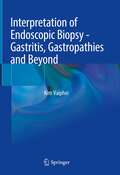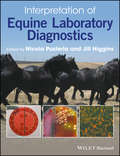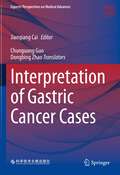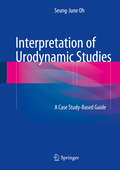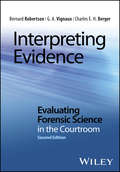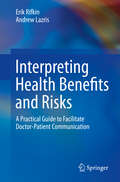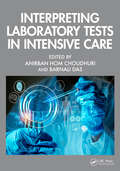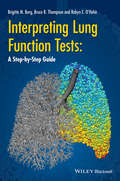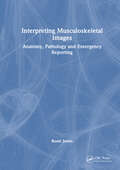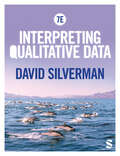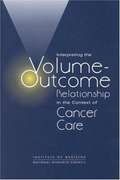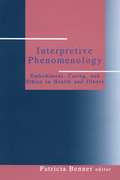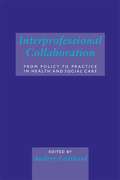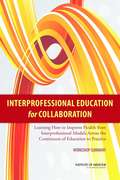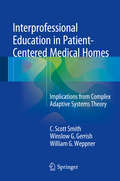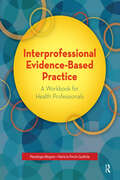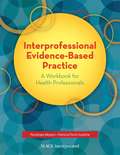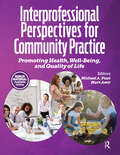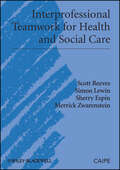- Table View
- List View
Interpretation of Endoscopic Biopsy - Gastritis, Gastropathies and Beyond
by Kim VaipheiThe book covers all aspects of endoscopic biopsies of the stomach inclusive of gastritis and gastropathies. It highlights the best way of handling of endoscopic biopsies in the endoscopic room by the gastroenterologist. It elucidates various steps involved in processing of the biopsy, tissue embedding and paraffin sectioning, approach to interpretation, various precautions that require to be taken while interpreting the biopsies, and the essential background knowledge of the interpreter. The book highlights the importance of the little things for a proper reading like matching of the tissue fragments received and the number of tissue present on a slide after the paraffin section.Chapters cover various forms of gastritis, and the easiest approach for daily routine by avoiding the cumbersome classifications and staging formulated for gastritis. It also discusses the utilization of the right nomenclature for acute and chronic gastritis and various other subtypes of gastritis. Chapters include various rarer and infrequently come across conditions of both acute and chronic gastritis, special form of gastritis and infective conditions. It also includes unusual forms of non-neoplastic gastric pathologies such as, a condition, where the gastric mucosa is affected not only by direct exposure to various irritants but may also be affected by many systemic diseases. It also highlights the frequently observed changes in chronic renal and liver failures. The book is targeted to all the practicing pathologists as well as graduate and post graduate students who are keen to learn about non-neoplastic gastric pathology at various levels.
Interpretation of Equine Laboratory Diagnostics
by Nicola Pusterla Jill HigginsInterpretation of Equine Laboratory Diagnostics offers a comprehensive approach to equine laboratory diagnostics, including hematology, clinical chemistry, serology, body fluid analysis, microbiology, clinical parasitology, endocrinology, immunology, and molecular diagnostics. Offers a practical resource for the accurate interpretation of laboratory results, with examples showing real-world applications Covers hematology, clinical chemistry, serology, body fluid analysis, microbiology, clinical parasitology, endocrinology, immunology, and molecular diagnostics Introduces the underlying principles of laboratory diagnostics Provides clinically oriented guidance on performing and interpreting laboratory tests Presents a complete reference to establish and new diagnostic procedures Offers a practical resource for the accurate interpretation of laboratory results, with examples showing real-world applications Covers hematology, clinical chemistry, serology, body fluid analysis, microbiology, clinical parasitology, endocrinology, immunology, and molecular diagnostics Introduces the underlying principles of laboratory diagnostics Provides clinically oriented guidance on performing and interpreting laboratory tests Presents a complete reference to established and new diagnostic procedures
Interpretation of Gastric Cancer Cases (Experts' Perspectives on Medical Advances)
by Jianqiang CaiThis book covers the diagnosis and treatment of various types of gastric cancer, and details the clinical process of gastric cancer treatment. Authors collects 37 clinical cases, which are typical gastric cancer cases with complicated disease or metastasis. In each case, the patient's gastroscopic results, abdominal CT images, pathological results and treatment process were analysed in detail. Combined with the expert's precise comments, the surgical treatment method and postoperative radiotherapy and chemotherapy and other treatment schemes of each case were clearly explained in an orderly manner.
Interpretation of Urodynamic Studies: A Case Study-Based Guide
by Seung-June OhThis book is a comprehensive guide to lower urinary tract dysfunction that draws extensively on actual urodynamic traces and patient cases to ensure that the imparted knowledge will be readily transferable to clinical practice. The impressive collection of clinical cases is used to illustrate basic concepts of lower urinary tract function and to document urodynamic findings and typical patterns in a wide range of commonly encountered conditions. In addition, attention is drawn to frequent pitfalls and artifacts. Readers will be able to assess their skill in reaching the correct diagnostic conclusion in each case, as in addition to the urodynamic trace a full set of information is provided on aspects such as patient history, physical examination, voiding diary, laboratory examination, imaging studies, and cystourethroscopy, thereby directly simulating real-life clinical practice. The presented cases are drawn from the large clinical database that Professor Seung-June Oh has prospectively accumulated during the past 16 years of clinical practice. The book will be invaluable for residents and other practitioners and will also be of interest for medical students.
Interpretation of Vertigo Cases (Experts' Perspectives on Medical Advances)
by Xizheng Shan Entong WangThis book includes 35 vertigo cases, which covers typical cases, difficult cases and rare cases from the department of otorhinolaryngology, neurology, emergency department, geriatrics, ophthalmology, and other disciplines. In each case, it has uniform structure, which includes summary of medical records, case study and case view.This book starts from peripheral vertigo, which is the most common vertigo disease, and belong to vestibular vertigo. It also covers non-vestibular vertigo, which is rare and might be ignored to get timely diagnosis and treatment. In addition, it introduces the patient who have multiple vertigo diseases, which are difficult to diagnosis and treatment, but also easy to be missed or misdiagnosed.This book will be helpful to deeply understand vertigo diseases and improve the diagnosis and treatment of vertigo diseases.The translation was done with the help of artificial intelligence (machine translation by the service DeepL.com). A subsequent human revision was done primarily in terms of content.
Interpreting ECGs in Clinical Practice (In Clinical Practice)
by Sercan Okutucu Ali OtoThis book is designed to teach healthcare professionals how to interpret electrocardiograms, presenting this information with numerous illustrations, solid practical content, questions to prompt critical thinking, case presentations, and plentiful practice ECG tracings to promote the application of skills.Interpreting ECGs in Clinical Practice is practical book rather than a “theoretical book.” Although there is plenty of detail, the coverage is to the point, telling the reader the salient points and then showing what needs to be taken away. The breadth of information ranges from simple to complex, but regardless of how advanced the material, the explanations and visuals make the concepts easy to understand, making this a critical resource for all cardiology professionals.
Interpreting Evidence: Evaluating Forensic Science in the Courtroom
by Bernard Robertson G. A. Vignaux Charles E. BergerThis book explains the correct logical approach to analysis of forensic scientific evidence. The focus is on general methods of analysis applicable to all forms of evidence. It starts by explaining the general principles and then applies them to issues in DNA and other important forms of scientific evidence as examples. Like the first edition, the book analyses real legal cases and judgments rather than hypothetical examples and shows how the problems perceived in those cases would have been solved by a correct logical approach. The book is written to be understood both by forensic scientists preparing their evidence and by lawyers and judges who have to deal with it. The analysis is tied back both to basic scientific principles and to the principles of the law of evidence. This book will also be essential reading for law students taking evidence or forensic science papers and science students studying the application of their scientific specialisation to forensic questions.
Interpreting Health Benefits and Risks
by Erik Rifkin Andrew LazrisThis timely guide to communication in patient-centered medicine argues for greater clarity in explaining health risks versus benefits of an array of screening tests, procedures, and drug regimens. It reviews the growing trend toward patients' involvement in their own care, particularly in terms of chronic conditions, and details approaches physicians can use to prepare patients (and themselves) for collaborative decision-making based on informed choices and clear, meaningful knowledge. Chapters apply this lens to a wide range of common interventions as contentious as estrogen replacement therapy and antibiotics, and as widely prescribed as the daily aspirin and the annual physical. With this goal in mind, the authors also introduce an innovative decision-making tool that translates risks and benefits into a clear graphic format for fewer chances of miscommunication or misunderstanding. Among the topics covered: Involving the patient in decision making. Towards a universal decision aid. BRCT: the Benefit/Risk Characterization Theater. Breast Cancer Screening--Mammograms. Prostate Cancer Screening. Colon cancer screening with colonoscopy. Screening for and treating dementia. Statins, cholesterol, and coronary heart disease. Physicians in family and internal medicine will find Interpreting Health Benefits and Risks: A Practical Guide to Facilitate Doctor- Patient Communication a valuable resource for communicating with patients and new possibilities for working toward their better health and health education. This book considers several common and important situations where faulty decision-making makes overtreatment a serious risk. Clear, fair, referenced, and useful information is provided. And a powerful intuitive technique is introduced which allows patient and doctor to talk as equals as they work together in the exam room. The authors emphasize that some patients who have been fully educated will still accept high risks of harm for a small chance of avoiding premature death. But as this book is accepted and its ideas and technique are extended, I feel sure that net harm to patients will be curtailed. And what is more, the integrity of the decision-making process will be improved. --Thomas Finucane, MD, Professor of Medicine, Division of Gerontology and Geriatric Medicine, The Johns Hopkins University School of Medicine
Interpreting Laboratory Tests in Intensive Care
by Anirban Hom Choudhuri and Barnali DasThis book incorporates a wide variety of clinical conditions requiring admission to the intensive care unit that necessitate timely performance of diagnostic tests and their correct interpretation to guide the best treatment. It tries to translate complex physiological principles and diagnostic algorithms into a clinically relevant format that can be easily understood by clinicians. It also explains at length the key clinical inputs to be acquired by laboratory physicians before reporting the results and tries to solve the common dilemmas leading to misinterpretation. The importance of every detail, from sample collection and dispatch to correlation of clinical state report, has been adequately explained with suitable examples and proper explanations.
Interpreting Lung Function Tests
by Bruce Thompson Robyn O Hehir Brigitte BorgLung function assessment is the central pillar of modern respiratory diagnosis, providing invaluable information to assist in clinical decision making and management strategies.Interpreting Lung Function Tests: A Step-by Step Guide is a practical "how-to" training manual, which provides the reader with the necessary skills to interpret lung function test results, and to write a concise and informative report on the outcome.Interpreting Lung Function Tests: A Step-by Step Guide provides unique guidance on the reporting of pulmonary function tests, including illustrative cases and sample reports.utilizes the many references available on interpretation of lung function and provides a teaching/reference tool for report writing of lung function results routinely performed in clinical practice.provides the reader with the skill to interpret and write a concise, yet informative reportprovides examples of results and written reports (with commentary where necessary as further explanation).focuses primarily on tests performed as part of routine clinical testing: spirometry, static lung volumes, gas transfer, bronchial provocation tests, and maximal respiratory pressures.Interpreting Lung Function Tests: A Step-by Step Guideis a superb new resource to educate medical students, junior doctors, family physicians, as well as advanced trainee physicians specializing in respiratory medicine, respiratory scientists, and respiratory physicians
Interpreting Musculoskeletal Images: Anatomy, Pathology and Emergency Reporting
by Rosie JonesThis visual manual is an accessible guide to musculoskeletal image interpretation and reporting, including common trauma pathologies, arthropathies, mechanisms of injury and classification systems. Beautifully illustrated with schematic line diagrams, supplemented with radiographs and scans, the content has been developed to enhance learning and understanding of both radiology and anatomy, and the relationship between them.Key features: Concise, yet highly informative Large, high-quality illustrations supplement and enhance the written descriptions, with colour-coding for rapid matching of image to corresponding text Relates imaging to underlying anatomy and pathology, aiding accurate interpretation Carefully designed to support rapid access in the clinical setting and ideal also as a revision aid during examination preparation The book delivers hands-on support to junior doctors, other emergency medicine personnel and practising radiographers for use in the clinical setting and is also ideal for students preparing for qualifying examinations in medicine and radiography.
Interpreting Professional Self-Regulation: A History of the United Kingdom Central Council for Nursing, Midwifery and Health Visiting
by Celia Davies Abigail BeachInterpreting Professional Self-Regulation analyses the contribution made by the UKCC to the development of the nursing profession in this country over the last 30 years.It details the key issues the council grappled with during this time and provides in-depth analyses of the complexity of these issues.There is a general consensus that the current view of nursing's regulatory body will culminate in a major shake up of the way the nursing profession is governed and in which the UKCC will be radically transformed. This publication of the history of the UKCC will mark the close of a very significant period in nursing's history and the opening of wider debates about ensuring the safety of the public through regulation of health professionals.This is an important text for all those who teach on professional and policy issues in nursing, giving them a factual background that has never been brought together before, enabling them to bring discussion of post-registration education, discipline and other professional matters more firmly into the curriculum.
Interpreting Qualitative Data
by David SilvermanIn his signature pragmatic and friendly style, David Silverman acts as your stand-in supervisor in the seventh edition of this book, taking you step-by-step through different methods for making sense of qualitative data. Whether you are interested in analysing visual images, interviews, focus groups or online data, this book provides a clear framework for using qualitative data to answer your research questions. The book provides: • A strong grounding in research design principles so you can embed best practice into your research project. • Diverse real-world examples so you can see how principles are applied in practice. • Coverage of new developments in qualitative research including working with online data. If you are new to qualitative research or conducting your first research project in the social sciences, this book gives you the practical grounding in qualitative methods you need to get started.
Interpreting Qualitative Data
by David SilvermanIn his signature pragmatic and friendly style, David Silverman acts as your stand-in supervisor in the seventh edition of this book, taking you step-by-step through different methods for making sense of qualitative data. Whether you are interested in analysing visual images, interviews, focus groups or online data, this book provides a clear framework for using qualitative data to answer your research questions. The book provides: • A strong grounding in research design principles so you can embed best practice into your research project. • Diverse real-world examples so you can see how principles are applied in practice. • Coverage of new developments in qualitative research including working with online data. If you are new to qualitative research or conducting your first research project in the social sciences, this book gives you the practical grounding in qualitative methods you need to get started.
Interpreting the Volume-Outcome Relationship in the Context of Cancer Care
by National Cancer Policy BoardInformation on Interpreting the Volume-Outcome Relationship in the Context of Cancer Care
Interpretive Phenomenology: Embodiment, Caring, and Ethics in Health and Illness
by Patricia Ellen BennerPatricia Benner's introduction to phenomenology develops the reader's understanding of the strategies and processes involved in this innovative approach to nursing. The author discusses the relationship between theory and practice, considers the possibility of a science of caring from a feminist perspective, introduces interpretive phenomenology to the study of natural groups such as families, and suggests a basis for developing nursing ethics that is true to the caring and healing practices of the nursing profession.
Interprofessional Collaboration in Occupational Therapy
by Stanley Paul Cindee PetersonInteraction between professionals/students in various disciplines leads to greater respect, cooperation, and practical knowledge for all!Interprofessional Collaboration in Occupational Therapy, written by experienced occupational therapists, examines successful programs and models of practice involving collaboration between OT clinicians and allied health professionals. This vital information can help you deliver services to the elderly, the underserved, and the chronically ill that are more effective than traditional primary care models.This book will show you how to apply the concepts of interprofessional collaboration to: increase professional competence and public accountability improve the cost-effectiveness of the way your resources are used gain better evidence-based decision-making skills make more effective referrals avoid duplication of services to clients make better use of faculty time and classroom space by teaching subjects common to various health professions--anatomy, physiology, kinesiology, and other basic sciences
Interprofessional Collaboration: From Policy to Practice in Health and Social Care
by Audrey LeathardInterprofessional collaboration in the health and social care services has become a commanding force, spear-headed by the Government's modernisation programme to improve partnership. Interprofessional Collaboration highlights the benefits and factors arising from working together for patients, service users and carers through a review of theoretical models illustrated by relevant examples. Discussion of topical problems being faced by practitioners, managers, and policy-makers in the health and social care sector covers:*Policy issues from various interprofessional angles, including the place of management, ethical issues and technology*The application of policy to practice in working together across professions, sectors and communities, giving an overview of teamwork, new primary care policies, interprofessional agendas for family support and mental health, and users' and carers' perspectives on collaboration in practice*Policy and practice in learning together, including theoretical challenges and developments internationally.Relevant for all those that have an interest in matters of health, social care, welfare and caring, Interprofessional Collaboration provides comprehensive coverage on interprofessional education and policy in the UK and abroad.
Interprofessional Education for Collaboration
by Institute of Medicine Board on Global Health Patricia A. Cuff Global Forum on Innovation in Health Professional EducationEvery year, the Global Forum undertakes two workshops whose topics are selected by the more than 55 members of the Forum. It was decided in this first year of the Forum's existence that the workshops should lay the foundation for future work of the Forum and the topic that could best provide this base of understanding was "interprofessional education." The first workshop took place August 29-30, 2012, and the second was on November 29-30, 2012. Both workshops focused on linkages between interprofessional education (IPE) and collaborative practice. The difference between them was that Workshop 1 set the stage for defining and understanding IPE while Workshop 2 brought in speakers from around the world to provide living histories of their experience working in and between interprofessional education and interprofessional or collaborative practice. A committee of health professional education experts planned, organized, and conducted a 2-day, interactive public workshop exploring issues related to innovations in health professions education (HPE). The committee involved educators and other innovators of curriculum development and pedagogy and will be drawn from at least four health disciplines. The workshop followed a high-level framework and established an orientation for the future work of the Global Forum on Innovations in Health Professional Education. Interprofessional Education for Collaboration: Learning How to Improve Health from Interprofessional Models Across the Continuum of Education to Practice summarizes the presentations and small group discussions that focused on innovations in five areas of HPE: 1. Curricular innovations - Concentrates on what is being taught to health professions' learners to meet evolving domestic and international needs; 2. Pedagogic innovations - Looks at how the information can be better taught to students and WHERE education can takes place; 3. Cultural elements - Addresses who is being taught by whom as a means of enhancing the effectiveness of the design, development and implementation of interprofessional HPE; 4. Human resources for health - Focuses on how capacity can be innovatively expanded to better ensure an adequate supply and mix of educated health workers based on local needs; and 5. Metrics - Addresses how one measures whether learner assessment and evaluation of educational impact and care delivery systems influence individual and population health.
Interprofessional Education in Patient-Centered Medical Homes
by C. Scott Smith Winslow G. Gerrish William G. WeppnerThis book discusses the application of complex adaptive systems theory to the design and evaluation of patient-centered medical homes (PCMHs). The three defining goals of PCMHs are to spread patient-care roles among healthcare team members, focus on disease prevention and include the patient in the healthcare team. It explains why some PCMH pilots are highly successful while others do not show much benefit, covers specific sub-theories that allow for bracketing of different aspects of the clinic system and highlights strategies by which institutions can engage in this process. Inter professional Education in Patient-Centered Medical Homes is a valuable resource for faculty and managers of health professions teaching clinics, deans of medical and health professional schools and medical administrators.
Interprofessional Evidence-Based Practice: A Workbook for Health Professionals
by Penelope Moyers Patricia Finch-GuthrieInterprofessional Evidence-Based Practice: A Workbook for Health Professionals promotes active, team learning of interprofessional evidence-based practice (EBP). This book is distinctive in that it departs from the tradition of evidence-based practice occurring from a single disciplinary perspective. Interprofessional evidence-based practice is described in terms of a dynamic team process that blends the patient’s preferences and values, the expertise of practitioners from multiple disciplines, and incorporates multidisciplinary evidence. Teams learn to use the nine phases in the interprofessional process to challenge current disciplinary paradigms and biases to create an integrated approach to patient care, healthcare delivery, or population health.Drs. Penelope Moyers and Patricia Finch Guthrie focus on developing and fostering collaboration between academic institutions and healthcare organizations so that students and faculty participate on interprofessional teams with mentors and staff from a healthcare organization. Interprofessional Evidence-Based Practice: A Workbook for Health Professionals also addresses the communication and cross-organizational factors important for supporting the work of the team. Common team and mentoring issues encountered in EBP are clearly articulated, along with the iterative problem-solving approaches necessary to mitigate temporary “stumbling blocks.”The book provides detail for developing and launching an Interprofessional Evidence-Based Practice program that goes beyond the evidence process to include implementation science to support practice change. Approaches for developing partnerships for supporting this type of program between universities and health care institutions are contained within, including sample partnership agreements and resource-sharing strategies.Inside Interprofessional Evidence-Based Practice: A Workbook for Health Professionals, each chapter includes performance objectives, key words, checklists, and materials and resources that an interprofessional team can use. PowerPoint lectures, mentor newsletters, forms, tools, and other resources are included on a companion website to guide team learning about key EBP topics, as well as to support the program coordinators and team mentors in their work with the interprofessional teams.Interprofessional Evidence-Based Practice: A Workbook for Health Professionals is the go-to resource for those who want to engage in interprofessional evidence-based practice, and for leaders who want to develop and implement an interprofessional evidence-based practice program.
Interprofessional Evidence-Based Practice: A Workbook for Health Professionals
by Penelope A. Moyers Patricia L. Finch-GuthrieInterprofessional Evidence-Based Practice: A Workbook for Health Professionals promotes active, team learning of interprofessional evidence-based practice (EBP). The book provides detail for developing and launching an Interprofessional Evidence-Based Practice program that goes beyond the evidence process to include implementation science to support practice change. Approaches for developing partnerships for supporting this type of program between universities and health care institutions are contained within, including sample partnership agreements and resource-sharing strategies. Each chapter includes performance objectives, key words, checklists, and materials and resources that an interprofessional team can use.
Interprofessional Perspectives for Community Practice: Promoting Health, Well-Being, and Quality of Life
by Michael Pizzi Mark AmirNow more than ever health care professionals play an increased role in the promotion of health to populations. Unique and innovative, Interprofessional Perspectives for Community Practice: Promoting Health, Well-being and Quality of Life weaves everyday care into prevention, community, and population health, creating a new and more expansive vision of health for all without compromising traditional practices.Authors and editors Drs. Pizzi and Amir discuss and illustrate a client-centered preventive and health, well-being and quality of life approach rooted in best practice principles from interprofessional literature and firsthand experience. The text illustrates how allied health professionals implement those principles in their everyday and traditional practices with an emphasis on exploring health and well-being issues. Interprofessional Perspectives for Community Practice provides detailed guidance in program development and implementation.What’s included in Interprofessional Perspectives for Community: Clinical anecdotes on successful community practices A focus on primary and secondary prevention Assessments, interventions, and community practice examples Descriptions of community-based practice settings such as adult day care, independent living programs, hospice, and home health care Health and wellness across the lifespan Bonus chapters available online as PDFs for readers The first text of its kind to weave interprofessionalism, community practice, and health, well-being, and quality of life, Interprofessional Perspectives for Community Practice: Promoting Health, Well-being and Quality of Life is for all health care workers and students who wish to transfer practice skills from the clinical setting to a population-based program development model.
Interprofessional Rehabilitation
by William J. Taylor Sarah G. Dean Richard J. SiegertInterprofessional Rehabilitation: a Person-Centred Approach is a concise and readable introduction to the principles and practice of a person-centred interprofessional approach to rehabilitation, based upon a firm scientific evidence base.Written by a multi-contributor team of specialists in physiotherapy, occupational therapy, nursing, psychology and rehabilitation medicine, this text draws together common themes that cut across the different professional groups and the spectrum of health conditions requiring rehabilitation, and sets out a model of practice that is tailored to the specific needs of the client. Showing interprofessionalism at work in a range of clinical contexts, the book argues that effective rehabilitation is best conducted by well-integrated teams of specialists working in an interdisciplinary way, with the client or patient actively involved in all stages of the process.This book will be essential reading for students preparing for practice in an increasingly interprofessional environment, and will be of interest to any health care practitioner keen to understand how an integrated approach to rehabilitation can benefit their clients.
Interprofessional Teamwork for Health and Social Care (Promoting Partnership for Health #8)
by Simon Lewin Sherry Espin Scott Reeves Merrick ZwarensteinPROMOTING PARTNERSHIP FOR HEALTH This book forms part of a series entitled Promoting Partnership for Health publishedin association with the UK Centre for the Advancement of Interprofessional Education (CAIPE). The series explores partnership for health from policy, practice and educational perspectives. Whilst strongly advocating the imperative driving collaboration in healthcare, it adopts a pragmatic approach. Far from accepting established ideas and approaches, the series alerts readers to the pitfalls and ways to avoid them. DESCRIPTION Interprofessional Teamwork for Health and Social Care is an invaluable guide for clinicians, academics, managers and policymakers who need to understand, implement and evaluate interprofessional teamwork. It will give them a fuller understanding of how teams function, of the issues relating to the evaluation of teamwork, and of approaches to creating and implementing interventions (e.g. team training, quality improvement initiatives) within health and social care settings. It will also raise awareness of the wide range of theories that can inform interprofessional teamwork. The book is divided into nine chapters. The first 'sets the scene' by outlining some common issues which underpin interprofessional teamwork, while the second discusses current teamwork developments around the globe. Chapter 3 explores a range of team concepts, and Chapter 4 offers a new framework for understanding interprofessional teamwork. The next three chapters discuss how a range of range of social science theories, interventions and evaluation approaches can be employed to advance this field. Chapter 8 presents a synthesis of research into teams the authors have undertaken in Canada, South Africa and the UK, while the final chapter draws together key threads and offers ideas for future of teamwork. The book also provides a range of resources for designing, implementing and evaluating interprofessional teamwork activities.
